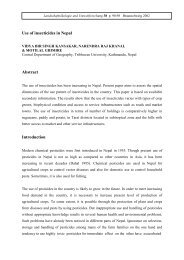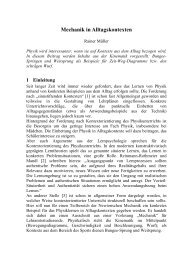Investigation of the electrocatalytic oxidation of formate and ethanol ...
Investigation of the electrocatalytic oxidation of formate and ethanol ...
Investigation of the electrocatalytic oxidation of formate and ethanol ...
Create successful ePaper yourself
Turn your PDF publications into a flip-book with our unique Google optimized e-Paper software.
J Solid State Electrochem (2006) 10:872–878 877<br />
With progressing experiment, when <strong>the</strong> microbial hydrogen<br />
production decreases <strong>and</strong> <strong>the</strong> concentrations <strong>of</strong> <strong>the</strong><br />
organic fermentation products have built up (usually 5 to<br />
20 mM <strong>of</strong> <strong>formate</strong> <strong>and</strong> <strong>ethanol</strong> are formed), <strong>the</strong> current<br />
density <strong>of</strong> <strong>the</strong> Pt electrode grows over that <strong>of</strong> Pt-PANI. The<br />
current <strong>of</strong> <strong>the</strong> latter electrode decreases to approach zero<br />
after approximately 12 h due to substrate exhaustion <strong>and</strong><br />
finished fermentation. The Pt black electrode, however, still<br />
continued delivering <strong>oxidation</strong> current due to <strong>the</strong> present<br />
level <strong>of</strong> dissolved <strong>formate</strong> <strong>and</strong> <strong>ethanol</strong>.<br />
As depicted in <strong>the</strong> chronoamperometric curves in Fig. 5,<br />
<strong>the</strong> <strong>oxidation</strong> <strong>of</strong> <strong>formate</strong> <strong>and</strong> <strong>ethanol</strong> at <strong>the</strong> platinum black<br />
modified electrodes is strongly pH-dependent. The chronoamperograms<br />
show <strong>the</strong> current response when incremental<br />
amounts <strong>of</strong> substrate are added to a pH 7 phosphate<br />
buffer solution (main figure) or to 0.1 M sulphuric acid.<br />
Curve A shows <strong>the</strong> background current, curves B <strong>and</strong> C <strong>the</strong><br />
current responses when <strong>ethanol</strong> <strong>and</strong> <strong>formate</strong> were incrementally<br />
added to reach <strong>the</strong> final concentration <strong>of</strong> 20 mM<br />
after <strong>the</strong> fifth addition. For <strong>the</strong> phosphate buffer solution<br />
current densities <strong>of</strong> about 5 mA cm −2 (<strong>formate</strong>) <strong>and</strong> 0.5 mA<br />
cm −2 (<strong>ethanol</strong>) were obtained.<br />
The inset <strong>of</strong> Fig. 5 shows <strong>the</strong> results <strong>of</strong> an experiment<br />
equal to that in <strong>the</strong> main figure but conducted in 0.1 M<br />
sulphuric acid. It is interesting to find that under <strong>the</strong> acidic<br />
conditions, both <strong>ethanol</strong> <strong>and</strong> <strong>formate</strong> <strong>oxidation</strong> do not appear<br />
to proceed to a significant extent. Whereas <strong>the</strong> <strong>ethanol</strong><br />
addition did not significantly change <strong>the</strong> background current<br />
(which is slightly negative: −7 μA cm −2 ) <strong>the</strong> addition <strong>of</strong><br />
<strong>formate</strong> resulted in only a small increase <strong>of</strong> <strong>the</strong> current signal.<br />
In Fig. 6, <strong>the</strong> dependence <strong>of</strong> <strong>the</strong> current density <strong>of</strong> <strong>the</strong><br />
<strong>formate</strong> <strong>oxidation</strong> on <strong>the</strong> solution pH is illustrated. The<br />
presented data represent <strong>the</strong> limiting current densities<br />
determined in potentiostatic experiments at <strong>the</strong> respective<br />
pH values. The figure clearly supports <strong>the</strong> above observation—<strong>the</strong><br />
current density <strong>of</strong> <strong>the</strong> <strong>formate</strong> <strong>oxidation</strong> grows as<br />
<strong>the</strong> solution pH increases. It reaches its maximum between<br />
pH 5.5 <strong>and</strong> 7.5. From <strong>the</strong> viewpoint <strong>of</strong> microbial fuel cells,<br />
this result is very important <strong>and</strong> promising, as that pH range<br />
is optimal for microbial growth.<br />
Conclusion<br />
Formate <strong>and</strong> <strong>ethanol</strong> are major products <strong>of</strong> microbial<br />
fermentation processes. With this basic study we have<br />
demonstrated that it is possible to utilize <strong>the</strong>se metabolic<br />
products <strong>of</strong> microbial cultures, provided <strong>electrocatalytic</strong><br />
platinum black electrodes are utilized in conjunction with a<br />
regenerative electrode pulsing. The rate <strong>of</strong> <strong>the</strong> <strong>electrocatalytic</strong><br />
<strong>formate</strong> <strong>oxidation</strong> was found to be significantly<br />
higher (tenfold) than that <strong>of</strong> <strong>ethanol</strong>. The current density for<br />
<strong>the</strong> <strong>ethanol</strong> <strong>oxidation</strong> may appear low; however, it is<br />
comparable to values reached in recent types <strong>of</strong> microbial<br />
fuel cells. The pH range <strong>of</strong> optimum microbial activity, i.e.,<br />
pH 5 to 7, was found most suitable for <strong>the</strong> electro-<strong>oxidation</strong><br />
processes.<br />
In previous communications, we have shown that<br />
hydrogen gas produced in microbial cultures under anaerobic<br />
conditions can be effectively oxidized by polyaniline<br />
<strong>and</strong> poly(tetra-fluoraniline)-covered platinum electrodes.<br />
The present paper clearly shows how it may be possible<br />
to tailor electrodes in such way that <strong>the</strong> goal <strong>of</strong> microbial<br />
fuel cells is realized, i.e., <strong>the</strong> complete, or almost complete,<br />
electrochemical <strong>oxidation</strong> <strong>of</strong> all <strong>the</strong> metabolic products <strong>of</strong><br />
anaerobic cultures. At <strong>the</strong> very end <strong>of</strong> <strong>the</strong>se developments,<br />
<strong>the</strong> microbial cultures will be used only to digest complex<br />
organic materials, e.g., cellulose, lignin, etc., to produce<br />
small metabolites as electron carriers that can be oxidized<br />
on electrodes.<br />
Acknowledgements U. S. gratefully acknowledges <strong>the</strong> support by<br />
<strong>the</strong> US Office <strong>of</strong> Naval Research, (ONR project N00014-03-1-0431)<br />
<strong>and</strong> by <strong>the</strong> Deutsche Forschungsgemeinschaft (DFG). U. S. <strong>and</strong> M. R.<br />
acknowledge <strong>the</strong> support by <strong>the</strong> Fonds der Chemischen Industrie.<br />
References<br />
1. González MJ, Hable CT, Wrighton MS (1998) J Phys Chem B<br />
102:9881–9890<br />
2. Lamy C, Belgsir EM, Leger J-M (2001) J Appl Electrochem<br />
31:799–809<br />
3. Nonaka H, Matsumura Y (2002) J Electroanal Chem 520:101–110<br />
4. Jiang J, Kucernak A (2002) J Electroanal Chem 520:64–70<br />
5. Shen PK, Tian Z (2004) Electrochim Acta 49:3107–3111<br />
6. Vigier F, Coutanceau C, Perrard A, Belgsir EM, Lamy C (2004)<br />
J Appl Electrochem 34:439–446<br />
7. Vigier F, Coutanceau C, Hahn F, Belgsir EM, Lamy C (2004)<br />
J Electroanal Chem 563:81–89<br />
8. Kita H, Katagiri T (1987) J Electroanal Chem 220:125–138<br />
9. Mathiyarasu J, Remona AM, Mani A, Phani KLN, Yegnaraman V<br />
(2004) J Solid State Electrochem 8:968–975<br />
10. Skowronski JM, Wazny A (2005) J Solid State Electrochem<br />
9:890–899<br />
11. Shafia Hoor F, Ahmed MF, Mayanna SM (2004) J Solid State<br />
Electrochem 8:572–576<br />
12. Chen Z-F, Jiang Y-X, Wang Y, Xu J-M, Jin L-Y, Sun S-G (2005)<br />
J Solid State Electrochem 9:363–370<br />
13. Tharamani CN, Shafia Hoor F, Begum NS, Mayanna SM (2005)<br />
J Solid State Electrochem 9:476–482<br />
14. Vielstich W, Lamm A, Gasteiger HA (2003) Wiley, Chichester<br />
15. Koscher GA, Kordesch KJSSE (2003) J Solid State Electrochem<br />
7:632–636<br />
16. Nießen J, Schröder U, Harnisch F, Scholz F (2005) Lett Appl<br />
Microbiol 41:286–290<br />
17. Nießen J, Schröder U, Scholz F (2004) Electrochem Commun<br />
6:955–958<br />
18. Rosenbaum M, Schröder U, Scholz F (2005) Environ Sci Technol<br />
39:6328–6333<br />
19. Schröder U, Nießen J, Scholz F (2003) Angew Chem Int Ed Engl<br />
115:2986–2989











